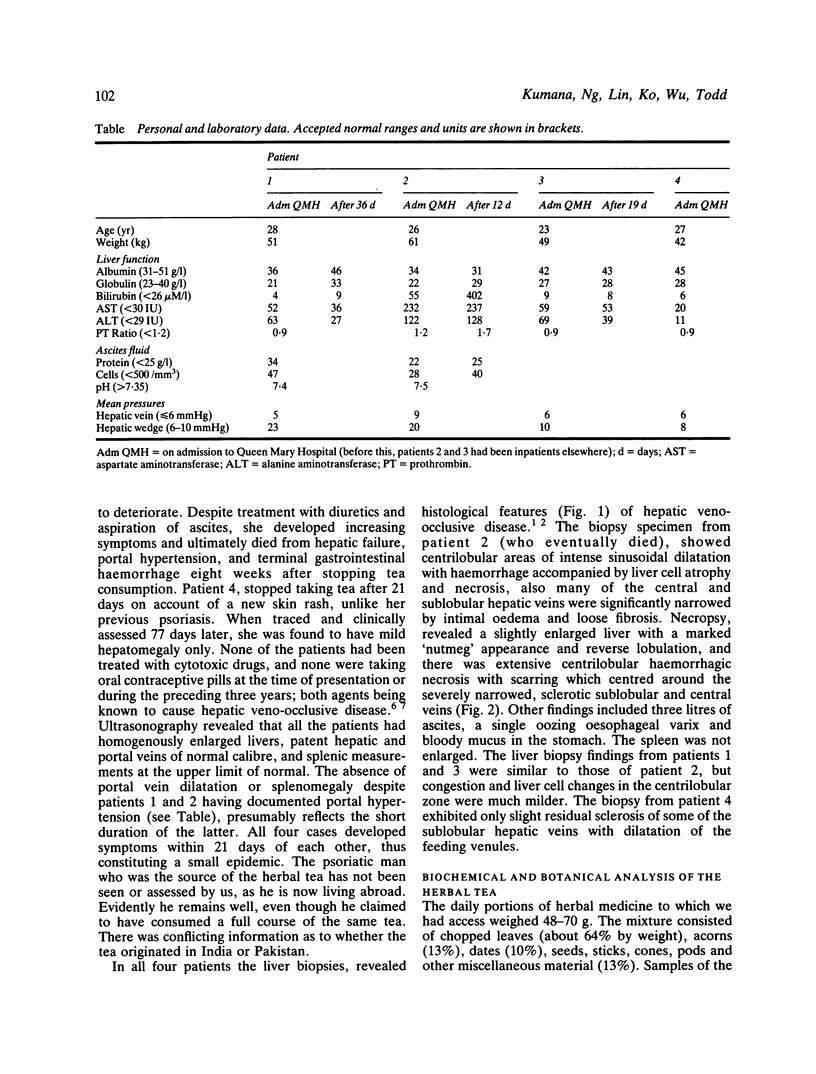Abstract
Four young Chinese women took daily doses of an unidentified 'Indian' herbal tea as treatment for psoriasis. Three (one of whom died), developed ascites, hepatomegaly and biochemical abnormalities within 19-45 days. The fourth patient discontinued herbal tea after 21 days when she developed a skin rash. Two patients had portal hypertension, while all had liver histology showing features of veno-occlusive disease. Pyrrolizidine alkaloids were identified spectrophotometrically in the brewed tea, and in the chopped leaves of the herbal mixture; the mean dose in the tea prepared for consumption being 12 mg/day of alkaloid base and 18 mg/day of N-oxide. The mean cumulative dose of alkaloids (base + N-oxide) before onset of symptoms (three patients), was estimated to be 18 mg/kg. In the asymptomatic patient with histological liver disease only, the corresponding dose was 15 mg/kg. These cases thus provide some measure of pyrrolizidine alkaloid toxicity in adults.
Full text
PDF



Images in this article
Selected References
These references are in PubMed. This may not be the complete list of references from this article.
- Alpert L. I. Veno-occlusive disease of the liver associated with oral contraceptives: case report and review of literature. Hum Pathol. 1976 Nov;7(6):709–718. doi: 10.1016/s0046-8177(76)80082-2. [DOI] [PubMed] [Google Scholar]
- Datta D. V., Khuroo M. S., Mattocks A. R., Aikat B. K., Chhuttani P. N. Herbal medicines and veno-occlusive disease in India. Postgrad Med J. 1978 Aug;54(634):511–515. doi: 10.1136/pgmj.54.634.511. [DOI] [PMC free article] [PubMed] [Google Scholar]
- GUPTA P. S., GUPTA G. D., SHARMA M. L. Veno-occlusive disease of liver. Br Med J. 1963 May 4;1(5339):1184–1186. doi: 10.1136/bmj.1.5339.1182. [DOI] [PMC free article] [PubMed] [Google Scholar]
- Hou J. G. [Veno-occlusive disease of the liver with report of 2 cases (author's transl)]. Zhonghua Nei Ke Za Zhi. 1980 May;19(3):187–191. [PubMed] [Google Scholar]
- Huxtable R. J. Herbal teas and toxins: novel aspects of pyrrolizidine poisoning in the United States. Perspect Biol Med. 1980 Autumn;24(1):1–14. doi: 10.1353/pbm.1980.0078. [DOI] [PubMed] [Google Scholar]
- Mattocks A. R. Spectrophotometric determination of unsaturated pyrrolizidine alkaloids. Anal Chem. 1967 Apr;39(4):443–447. doi: 10.1021/ac60248a006. [DOI] [PubMed] [Google Scholar]
- Mohabbat O., Younos M. S., Merzad A. A., Srivastava R. N., Sediq G. G., Aram G. N. An outbreak of hepatic veno-occlusive disease in north-western Afghanistan. Lancet. 1976 Aug 7;2(7980):269–271. doi: 10.1016/s0140-6736(76)90726-1. [DOI] [PubMed] [Google Scholar]
- STUART K. L., BRAS G. Veno-occlusive disease of the liver. Q J Med. 1957 Jul;26(103):291–315. [PubMed] [Google Scholar]
- Smith L. W., Culvenor C. C. Plant sources of hepatotoxic pyrrolizidine alkaloids. J Nat Prod. 1981 Mar-Apr;44(2):129–152. doi: 10.1021/np50014a001. [DOI] [PubMed] [Google Scholar]
- Tandon B. N., Tandon H. D., Tandon R. K., Narndranathan M., Joshi Y. K. An epidemic of veno-occlusive disease of liver in central India. Lancet. 1976 Aug 7;2(7980):271–272. doi: 10.1016/s0140-6736(76)90727-3. [DOI] [PubMed] [Google Scholar]
- Weitz H., Gokel J. M., Loeschke K., Possinger K., Eder M. Veno-occlusive disease of the liver in patients receiving immunosuppressive therapy. Virchows Arch A Pathol Anat Histol. 1982;395(3):245–256. doi: 10.1007/BF00429351. [DOI] [PubMed] [Google Scholar]




